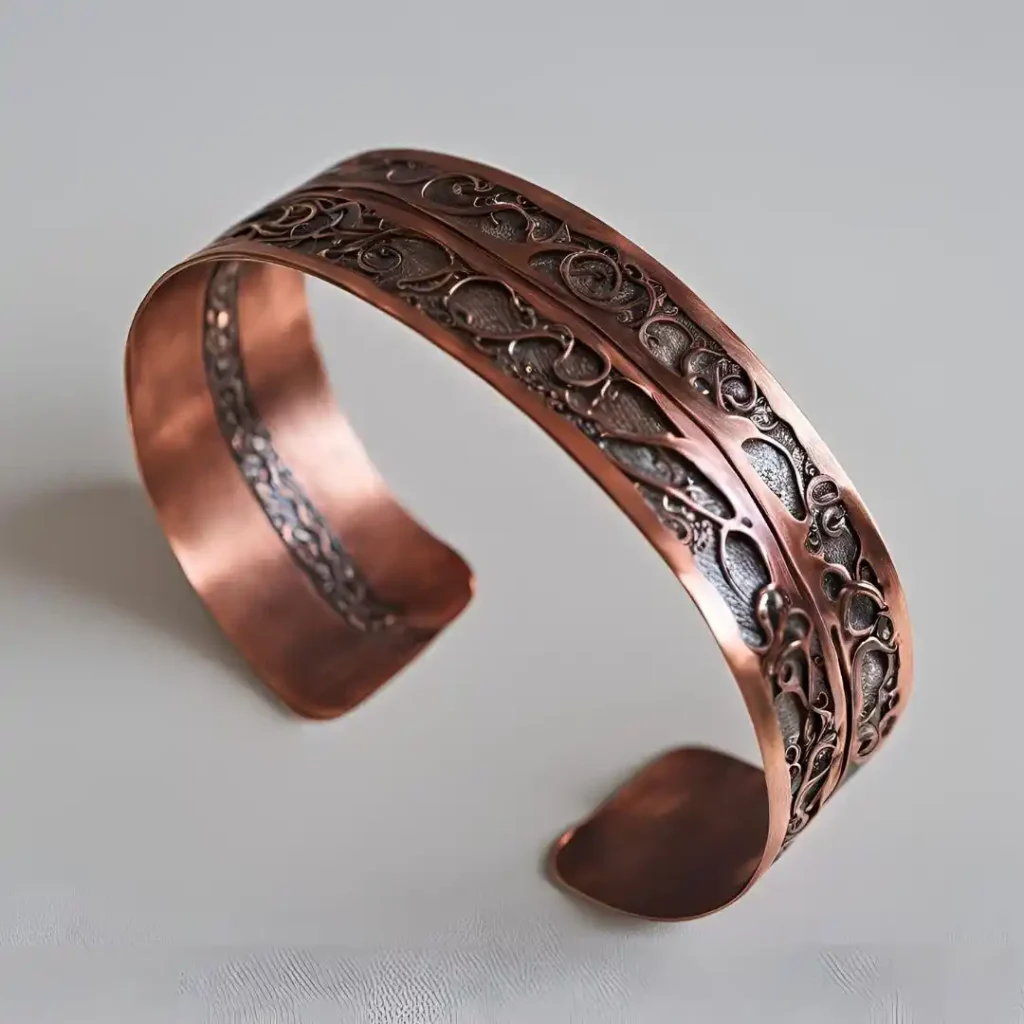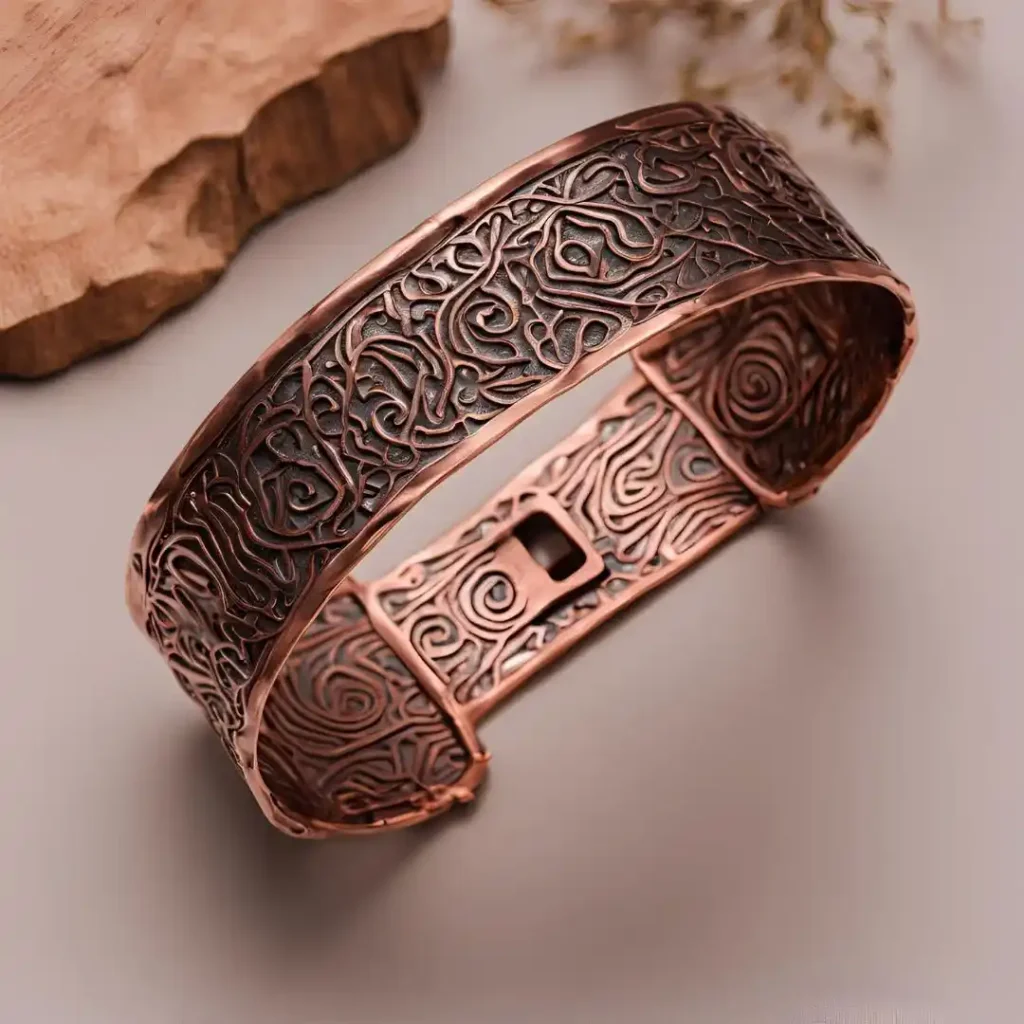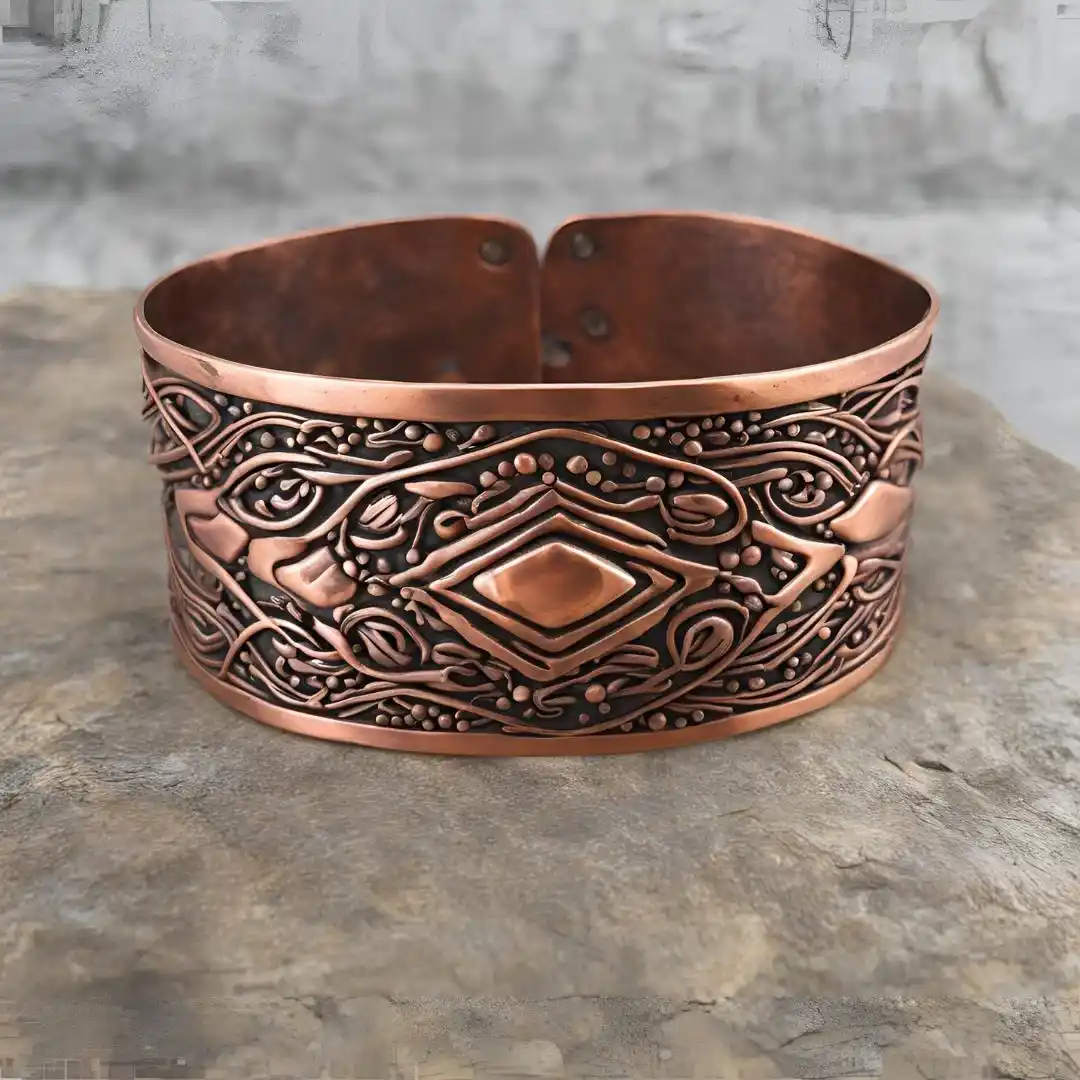The allure of copper bracelets has captivated many, often overshadowing the awareness of the side effects of wearing copper bracelet.
This article brings to light these overlooked aspects, filled with valuable information and tips from experts to use these bracelets both safely and effectively.
While the health benefits of copper are widely recognized, the side effects should not be ignored.
Users might experience skin irritation, discoloration, or allergic reactions.
It’s not unusual to see a green or blue stain on the wrist, especially for those with sensitive skin, leading to symptoms like redness, itchiness, and even rashes.
For enthusiasts of copper bracelets, understanding these potential side effects is crucial.
Instead of having to ditch your bracelet, taking appropriate precautions can help mitigate these adverse effects.
This guide is designed to ensure that you can enjoy the health benefits of your copper bracelet without the discomfort of its side effects.
Also Read: Lapis Lazuli Negative Effects
What Are Copper Bracelets?
Copper bracelets have been a staple in alternative medicine for centuries. Traditionally worn on the wrist, these bracelets are more than just a piece of jewelry.
The idea behind them is fascinating: it’s believed that when in contact with the skin, copper metal is absorbed into the body, potentially helping to alleviate pain and inflammation related to various health problems.
How Do Copper Bracelets Work?
The effectiveness of copper bracelets remains a mystery even to many scientists and researchers.
Despite the intrigue it holds in the scientific community, the healing properties of these bracelets are yet to be fully understood.
Copper’s Role In The Body
Copper is an essential trace element playing a key role in various bodily functions.
It aids in the formation of red blood cells, supports the immune system, and is crucial for collagen production – a protein vital for healthy skin, hair, and nails.
When in contact with the skin, copper is absorbed into the body through sweat and other bodily fluids, often having positive effects on various bodily systems.
Also Read: Rose Quartz Breaking Meaning: A Positive Turn on Your Spiritual Journey
Balancing The Body’s Energy
Rooted in ancient wisdom, copper bracelets are believed to balance the body’s energy.
Drawing from ancient Indian medicine, they are thought to interact with the body’s chakras, or energy centers, promoting optimal health and balance energy for various health benefits.
Reducing Inflammation
Known for their anti-inflammatory properties, copper bracelets can help reduce pain, swelling, and inflammation.
This natural response to injury or infection can lead to chronic inflammation, associated with health problems like arthritis, heart disease, and even cancer.
Wearing these bracelets may prevent or alleviate these conditions.
Improving Circulation
Copper bracelets are also touted to improve circulation, contributing to numerous health benefits.
Enhanced circulation means more oxygen and nutrients reaching the body’s cells, boosting energy levels and overall health.
This also facilitates the removal of toxins and waste products, potentially easing issues like chronic fatigue, headaches, and skin problems.
Also Read: Who Should Not Wear Turquoise Stone: The Surprising Truth Revealed!
Is Wearing Copper Safe?
When it comes to copper, one key question often arises: is it safe?
Indeed, copper is more than a mere element; it’s an antimicrobial agent, known to inhibit a range of microorganisms, including bacteria, protozoa, fungi, and even some viruses.
This characteristic makes it valuable not only in the treatment of wounds and diseases but also as a critical trace element in the human body, contributing to the health of the brain, heart, skin, and immune system.
Its role in collagen and bone development is equally crucial. In the realm of metaphysics, copper is celebrated for its healing properties.
It’s believed to enhance blood circulation, remove toxins, reduce inflammation, and stabilize body metabolism.
Therefore, copper bracelets are often touted not just for their healing and protection but also for these holistic benefits.
However, it’s essential to note that they can turn skin green due to an oxidation reaction with oxygen in the environment, a harmless but notable effect.
Spiritual Benefits Of Wearing Copper Bracelet
Moving beyond the physical, copper bracelets offer spiritual benefits as well.
These bracelets, revered in many cultures, are believed to help with arthritis, joint pain, and even headaches.
Their antimicrobial properties are thought to fight off harmful bacteria and viruses, lending a sense of spiritual and physical well-being to the wearer.
Also Read: 14 Potential Side Effects Of Magnetic Bracelets You Need To Be Aware Of
Are There Disadvantages Of Wearing A Copper Ring In Astrology?
While astrology often speaks of the benefits, there are indeed Disadvantages to wearing a copper ring.
These drawbacks are not just myth but have real implications.

1. Copper Toxicity
One significant concern is copper toxicity. Although it’s unlikely for a copper bracelet to cause this, the risk increases when copper is ingested in large quantities.
This is more common with copper supplements or exposure to pesticides and fungicides.
Symptoms of copper toxicity include vomiting, nausea, a metallic taste, digestive discomfort, yellow eyes or skin, anorexia, depression, and muscle weakness.
2. Skin Discoloration
Another issue is skin discoloration. Copper bracelets can leave green or blue stains on the skin if worn for a long period.
This happens as copper, being soluble in sweat, gets absorbed into the bloodstream, causing discoloration. Though not harmful, it’s a visible proof of the process.
3. Skin Irritation
Skin irritation is a common problem associated with copper bracelets.
This irritation ranges from mild to moderate, primarily due to copper salts, known as natural irritants to human skin.
Symptoms like redness, itchiness, and discomfort are typical signs of an allergy or sensitivity to copper or other metals in the bracelet.
If these symptoms persist, it’s advisable to take off the bracelet.
Also Read: Uncovering The Shocking Side Effects Of Black Obsidian
4. Not Pure Copper Bracelet
A not pure copper bracelet often contains impurities or toxic metals like lead, posing additional health risks.
Symptoms of lead toxicity include low appetite, headaches, digestive problems, irritability, insomnia, lethargy, anemia, and hypertension.
It’s crucial to ensure the purity of the copper in your bracelet to avoid these issues.
5. Mineral Imbalances
Wearing a copper bracelet can also lead to mineral imbalances in the body.
Copper, when present in excess, can increase the level of zinc, a crucial nutrient for nervous system and immune function, as well as for maintaining healthy skin.
However, this increase can also decrease the level of other minerals, thereby disrupting crucial functions within the body.
6. Allergic Reactions To Metals
Wearing a copper bracelet can sometimes trigger metal allergy reactions.
Copper is among the common causes of metal allergies, leading to allergic symptoms such as redness, itching, and swelling.
Individuals with a history of metal allergies should avoid wearing a copper bracelet or test it for short periods while monitoring for any adverse reactions.
7. Interference With Medical Devices
Another concern is that copper can potentially interfere with certain medical devices, including pacemakers and defibrillators.
People with an implanted medical device are advised to avoid wearing a copper bracelet to prevent possible complications or interference with their device’s functionality.
8. Interaction With Medications
There’s also a risk that copper might interact with various medications, such as nonsteroidal anti-inflammatory drugs (NSAIDs), antibiotics, and antacids.
Anyone taking these medications should consult their doctor to understand the potential interactions that might arise from wearing a copper bracelet.
Also Read: The Dark Side Of Moonstone: 9 Side Effects Of Moonstone Revealed

9 Possible Side Effects Of Wearing A Copper Bracelet
While copper is known for its healing properties, such as reducing pain and inflammation in conditions like arthritis, there are several side effects associated with wearing a copper bracelet.
These bracelets, though often considered beneficial as a piece of jewelry, can have unexpected consequences.
1. Skin Irritation
Copper can sometimes irritate the skin, leading to reactions that cause discomfort, itchiness, or redness.
If you experience these symptoms with your copper bracelet, it may be due to the elements used in its production or allergies.
In such cases, it’s advisable to stop using the metal if it’s not suitable for your skin.
2. Very Itchy Wrists
Copper bracelets can also cause very itchy wrists, especially if your skin is allergic to copper.
This irritation can be attributed to the absorption of copper metal into the bloodstream.
When dissolved in sweat, copper can trigger skin reactions if worn too long.
An oxidation reaction between the copper and body sweat can lead to the dissolution and subsequent absorption of copper particles into the bloodstream, causing patches of blue or green color.
These are typical side effects of pure copper bracelets, unlike those made with black obsidian.
3. Headaches
Experiencing a headache can be an unpleasant side effect of wearing copper bracelets.
This issue often stems from copper toxicity, a condition where excess copper is absorbed into the bloodstream, leading to constant headaches and other related symptoms.
If you encounter such discomfort, it’s crucial to stop using the bracelet and ascertain the cause of the problem with the help of a medical practitioner.
4. Muscle Aches
Muscle aches are another potential issue when wearing a copper bracelet. This pain can arise when excess copper accumulates in the body and gets deposited in joints and tendons.
Such an excess concentration of copper can be unhealthy, leading to the weakening of bones and disrupting normal muscle function.
Also Read: Unveiling The Powerful Spiritual Meaning of Earrings Falling Out
5. Spiritual Unbalance
Regarding the spiritual aspect, copper has a known physical and spiritual connection.
It is believed to spark passion and positive energy and aid in maintaining focus.
However, an excessive amount in the body can hinder the healing process, causing lack of focus, confusion, instability, and a lack of direction.
If these symptoms arise, it’s recommended to stop using the bracelet.
6. Weakness Feeling
A weak feeling can occur when excess copper accumulates in the body, affecting the balance of other essential elements like zinc.
This imbalance can disrupt normal bodily functioning. The quantity of copper that leads to copper toxicity and weakness is important to consider.
Reducing or removing the copper bracelet may lessen absorption and alleviate this symptom.
7. Bad Mood
Copper can sometimes influence your bad mood. Its accumulation in the body can interfere with neurotransmitter activity and affect the thyroid and adrenal gland.
Excess copper may lead to low energy, adrenal stress, chronic fatigue, and an imbalance in neurotransmitter activity, affecting dopamine and norepinephrine levels.
This imbalance poses a risk of depression and other mental problems.
8. Somnolence
Copper in the body can also lead to somnolence. Although a necessary trace element in small quantities, it can act as a stimulant to mental activity and influence the body’s electricity.
However, excess copper can cause an adrenaline surge, leading to being overly hyper, impulsive, and experiencing anxiety, panic, restlessness, or insomnia.
9. Vomiting And Nausea
Copper bracelets can sometimes lead to vomiting and nausea, especially when there’s an accumulation of excess quantity of this trace element.
While beneficial in small amounts, excessive copper can strain the digestive system. If these symptoms occur, it’s advisable to stop wearing the bracelet to reduce absorption.
Also Read: Discover Who Should Not Wear Jade: The Surprising Truth
How To Choose The Right Type Of Copper Bracelet?
Choosing the right type of copper bracelet is crucial to minimize side effects.
Opt for a pure copper bracelet as it is less likely to cause skin irritation or discoloration compared to those made from copper alloy.
Ensure it’s comfortable, neither too tight nor too loose, to avoid skin issues.

1. Take Breaks And Avoid Wearing The Bracelet For Long Periods
It’s important to take breaks from wearing your copper bracelet. Continuous wear throughout the day increases the risk of side effects like skin irritation and discoloration.
Start with a few hours, then adjust gradually, and avoid long periods of continuous use.
2. Keep The Bracelet Clean
Regularly clean your copper bracelet using mild soap and water. This will help prevent skin irritation and discoloration.
Ensure it is dry thoroughly after washing and avoid using harsh chemicals or abrasive materials that could damage the bracelet or further irritate the skin.
3. Consider A Copper-Plated Bracelet
If you’re still facing issues, consider a copper-plated bracelet. These are made from a base metal like stainless steel or brass and are coated with a thin layer of copper, offering the benefits of copper with reduced risk of side effects.
4. Consult With Your Doctor
For persistent or severe side effects, consulting with your doctor is advisable.
They can help determine if the copper bracelet is causing the issue or if there’s an underlying medical condition that needs to be addressed, and provide guidance on alternative treatments.
Also Read: What They Don’t Tell You: The Dark Side Effects Of Blue Eye Bracelet
FAQs About Side Effects of Wearing Copper Bracelet
1. Should I Wear Magnetic Bracelets?
Magnetic bracelets may not offer direct physical health benefits, but some believe in their placebo effect for mental relief in pain and illness, like arthritis. However, if you have an electronic implant, such as a pacemaker, Holter monitor, or insulin pump, or if you’re pregnant or allergic to certain metals like nickel, it’s best to avoid them.
2. Should I Use The Copper Bracelet Left Or Right Wrist?
Whether to wear a copper bracelet on the left or right wrist doesn’t significantly impact its effectiveness. Copper is one of the body’s essential trace elements, believed to aid in healing stiff joints regardless of which wrist it’s worn on.
3. How Long Does It Take For A Copper Bracelet To Work?
The time it takes for a copper bracelet to show benefits can vary. Some people may notice effects within a few days, while for others, it might take weeks or longer to observe any significant changes.
4. Can You Wear Copper Bracelet To Bed?
Wearing a copper bracelet to bed can potentially offer health benefits, including improved circulation and deeper sleep patterns. The sulphates released from the copper can be beneficial for blood circulation, metabolism, and overall body health.
5. Can Copper Bracelets Cause Cancer?
According to the EPA, copper bracelets are not classified as a human carcinogen, as there are no adequate human or animal cancer studies to substantiate such a claim.
6. Is It Good To Wear A Copper Bracelet Everyday?
Wearing a copper bracelet everyday can be beneficial. It’s known to help with arthritis, stress, ageing, and immunity. Additionally, it may improve heart health, enhance spiritual vibrations, attract wealth, ward off negativity, and boost self-confidence.
7. When Not To Wear A Copper Bracelet?
Copper bracelets should be avoided by pregnant women and people with certain heart conditions or those who have a pacemaker or other magnetic medical devices. The metal in the bracelet can interact with these conditions.
8. Who Should Avoid Copper?
People with Wilson disease, which causes a buildup of copper in the brain, liver, kidneys, and eyes, should avoid copper. Also, individuals with hereditary conditions like idiopathic copper toxicosis and childhood cirrhosis should not take copper supplements.
Also Read: Can I Sleep With My Evil Eye Bracelet On

Final Thoughts
In conclusion, while copper bracelets have been a health trend for centuries, it’s essential to be aware of their potential side effects.
Common issues such as skin irritation, allergic reactions, and discoloration can occur, along with the possibility of interference with certain medical devices.
To mitigate these effects, choosing high quality, pure copper bracelets, keeping them clean, and wearing them for shorter periods are effective strategies.
It’s crucial for individuals with specific medical conditions or those taking certain medications to consult their doctor before embracing this trend.
The side effects of wearing copper bracelet are varied and can impact individuals differently, emphasizing the importance of cautious and informed usage.
